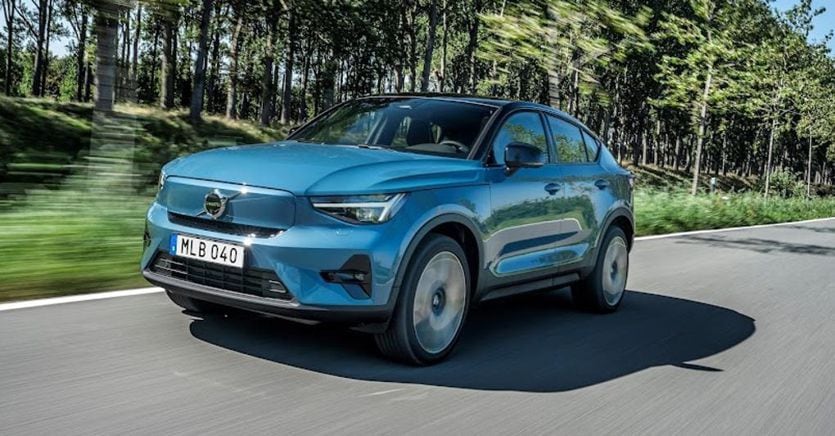The roadmap followed by Volvo to become a completely green brand by 2030 starts with the C40 Recharge. It is the first suv-coupe of the Swedish house and it is also the first offered exclusively with an electric powertrain as opposed to the XC40 which is available in thermal, plug-in hybrid and full electric P8 Recharge versions with 408 horsepower all-wheel drive on which it is based , in fact, the new model which therefore exploits the compact modular multi-energy Spa architecture.
The new Volvo brings back the letter C, previously assigned to some coupes, introducing the brand in a very trendy context. A logical choice, since the C40 Recharge in addition to confronting the institutional competition (Audi Q4 e-tron Sportback and Kia Ev6), also has to deal with the one it has at home from which it must, forcibly, distinguish itself. Therefore, it is different from other electric ones in the Geely galaxy (the Chinese giant that controls Volvo, Lynk & CO and Polestare) with which it shares the platform, the electrical network, other solutions and technologies. That is, not only the classic XC40 SUV but also the more powerful version of the Polestar 2 sedan. With its Chinese relative, the C40 also shares the fact that in some markets it can only be ordered online, just as it will be for all other Volvos in the future. In Italy this is not the case and it will be for a long time to come. Then, we go to the dealerships where, however, the only possible negotiation is the quotation of the used car. In fact, the price of the C40 Recharge is fixed throughout Europe. Obviously, subject to the variations introduced by the exchange rate between euros and other currencies and by slightly different endowments.
The C40 aesthetically distances itself from the XC40 relying only on the slender profile of the pavilion and the design of the tail, also distinguished by its 7 centimeters shorter stature. However, its appearance does not lose by the way neither the authority of an SUV nor the canons of Volvo’s design. The result is pleasant, but not rewarding for functionality. In fact, in the cockpit the general presentation equal to that of the XC40, which does not even give the opportunity to understand even the most extensive use of green materials, is flanked by a rear area that is less comfortably accessible and less high. The sleek silhouette also limits rear visibility and maneuvering and boot capacity, especially the maximum one slightly higher than the standard one. Like the homonymous XC40, the C40 also offers the infotainment system based on the Android Automotive operating system which, in addition to setting the connectivity bar very high with many standard or paid services, also offers the possibility of intervening on the powertrain efficiency. However, only by optimizing the energy flows based on navigation and the activity of some services, for example the air conditioning.
This is the only possible “loophole” to manage the efficiency-consumption ratio of the powertrain, because there are no eco, normal and sport modes. Regardless of this, the management of torque and power is very instinctive and precise, thanks to the beautiful dialogue between the accelerator pedal and the management electronics. No problem, then, if you want to go from a docile to an aggressive performance in the blink of an eye. Indeed, really aggressive if you think that you are driving a rather heavy medium-sized SUV. Precisely because of the weight, we must not expect sporty dynamism. In fact, the set-up is rather soft, so much so that it does not alter the valid comfort offered by the C40 even with the optional 20 ”wheels, present on the tested sample. The tall and thick wheels are not a cure-all for consumption. However, after nearly 190 kilometers on the flat Belgian roads but without overdoing it, the promised range of 440 kilometers felt quite realistic. In fact, after starting with 95% charge, we arrived at the end of the tour with 41% still available, thanks also to the incisiveness of the one-pedal mode in urban centers, although not very convenient to activate because “inside” the display of the ‘infotainment.
